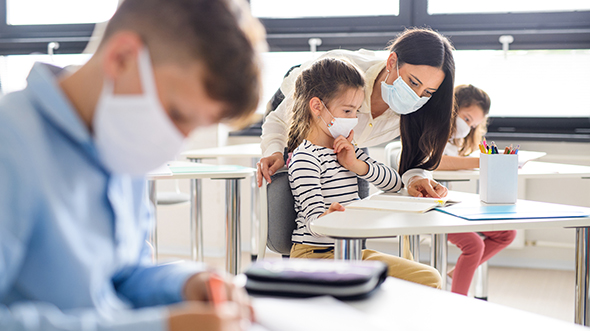
BLOG
—
Texas, Rhode Island School District Leaders Share Successes, Solutions from Pandemic
I moderated a recent Dude University panel with a group that works extensively with school facilities. We discussed the challenges and successes experienced with K-12 buildings during the COVID pandemic and their impact on educating students. A key point of the event was evaluating opportunities that we can apply moving forward per the lessons learned over the last year and a half.
Robert Robertson, associate superintendent of facilities and school services at Klein (Texas) Independent School District, and Dr. Joseph DaSilva, school construction coordinator for the School Building Authority at the Rhode Island Department of Education (RIDE), provided their firsthand experience and expertise as part of the panel. Being from Texas and Rhode Island, their experiences were very different. However, their focus on student education, creative solutions and moving forward with new lessons learned was shared.
It also was noted how regionalized the pandemic impact could be. Robertson reported very little impact from COVID infection at Klein, whereas DaSilva noted that his state saw some of the highest infection rates in the country. However, in both regions, well-ventilated, high-performance school buildings supported safe and robust in-person teaching. Additionally, the implementation of portable drinking water, hand sanitizing stations, structured entering and exiting of buildings, enhanced ventilation in nursing spaces and strategic isolation were all key to successful school re-openings last fall.
Devising, Leveraging Solutions
Creative solutions were implemented to keep schools operational. In Rhode Island, nonprofit environmental education programs successfully supported outdoor education, and HVAC systems upgraded to HEPA filtration systems. At Klein, HVAC operations were adjusted by increasing run time and air flow changes. One of the most creative solutions discussed involved changing human behavior. By installing plexiglass, adding ground markings and getting students to wash their hands more, Klein focused on making adjustments to high touch points to keep schools operational. For example, water fountains were shut down and bottle fillers installed to remove interaction with a high touch point surface.
For Rhode Island schools, the state provided robust guidelines with flexibility to support districts reopening. DaSilva emphasized the great work that was done at local school districts, which were able to devise creative solutions quickly and safely. Despite the high infection rates, he said RIDE was able to keep schools open because of the amount of work that went in at the district level in making multiple incremental adjustments.
At Klein, the biggest success reported was the collaboration between departments and organizations, which included:
- Food services delivered over 3.5 million meals curbside and 7 million meals to on-campus students
- Custodial staff ramped up disinfection
- Bus drivers delivering meals to neighborhoods
- Technology delivering tablets to students who didn’t have the equipment
Both Robertson and DaSilva highlighted how school districts were responding to the pandemic and developing solutions to educate students and open schools “ultimately while experts were developing guidelines to follow.”
Changing the Future of Education
Every region of the country was met with challenges during the pandemic, but schools have stepped up and made plans to build on that success. As Robertson said, “Let no crisis go unwasted,” noting that each school will take lessons learned and integrate them into school operations for the future. For example, currently on the floor of the Texas Legislature is a bill allowing school districts to provide a virtual option for learning beyond the pandemic. In the future, school design will incorporate HVAC enhancements and flexible furniture, which were both key to adapting to new learning situations.
DaSilva also emphasized three areas of focus for schools in the wake of the pandemic:
- Educational loss; the need to account for learning lost during this period
- Modernize facilities; this will help best prepare for the future, which likely will include other pandemics
- Social/emotional support: “We have all suffered some trauma as a result of the pandemic,” DaSilva said. “As adults, it’s been stressful, and it’s been very challenging for kids. We need to acknowledge that.”
In closing, Robertson stressed how school districts have played a key role in supporting communities across the country throughout the pandemic. “Think about where we would have been without public education stepping up and doing what was done during the pandemic to keep students fed, provide shelter, vaccine locations and testing centers.”
Education takes many forms, but schools and their leadership have led by example during the pandemic. We will continue to support their efforts and help create new solutions through facility improvements and innovation.

Jessica Goodell
Woolpert Senior Consultant Jessica Goodell, PE, has 13 years of experience in conducting facility condition assessments and forensic investigations. She has worked with some of the largest school districts in the U.S. and is skilled at not only understanding facilities and equipment but communicating data and report findings for K-12 institutions.


